Boletus L.
Recent molecular studies have shown that Boletus in its current circumscription is likely an artificial grouping and it is possible that it will be split at some point into smaller genera. Note that Boletus impolitus and Boletus depilatus for practical reasons are retained here, although there is strong evidence that they are closely related to Xerocomus subtomentosus and its allies.
Fruitbody large to medium sized, boletoid, without veil and ring. Stipe solid, with surface usually covered with granules or network. Flesh variously coloured, changing or not when exposed to air. Tubes easily separable from each other, not tearing apart. Pores usually small and rounded.
Boletus aereus Bull. : Fr.
Description
Cap up to 20 cm, hemispherical then convex, flat-convex, flat to depressed, initially dry, velvety, later smooth, sometimes slightly viscid, black brown, dark brown to chestnut brown, in young fruitbodies more or less uniformly coloured, later with irregular paler brown, bronze or orange brown spots, unchaning when bruised. Stipe clavate or rarely cylindrical, beige, orange brown to chestnut brown, rarely white or whitish, with fine network, surface unchanging when bruised. Flesh white, under the cuticle with dirty pink or pale brown tint, unchanging when exposed to air. Tubes initially white, then cream, pale yellow to yellow with olivaceous tint, unchanging when exposed to air. Pores concolorous with the tubes, unchanging when bruised. Smell not distinctive. Taste not distinctive. Spores 10.5–19.0 × 3.5–7.0 μm, ratio 1.9–4. Pileipellis (the cap cuticle) a trichodermium of interwoven septate hyphae. Cells of the hyphae long cylindrical, not incrusted. Chemical reactions: Hyphae of the stipe base inamyloid.
Habitat. Broadleaf forests, mycorrhizal with oaks (Quercus) or beech (Fagus).
Distribution. In Europe widespread, but much more common in south, in northern areas seen only on limestone, absent in the far north.
Note. One rather similar species has been described from under oaks in Moroco, namely Boletus mamorensis (see Redeuilh 1987). Research is needed to resolve its relationship with B. aereus and confirm its specific status.
Photographs

Typical young fruitbodies of Boletus aereus. Note the nearly uniform dark colouration of the cap. (photo M. Mikšík)
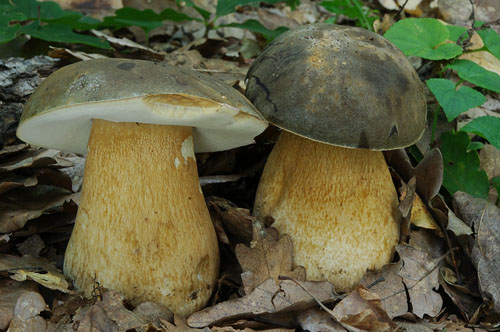
Fruitbodies of Boletus aereus. (photo M. Mikšík)
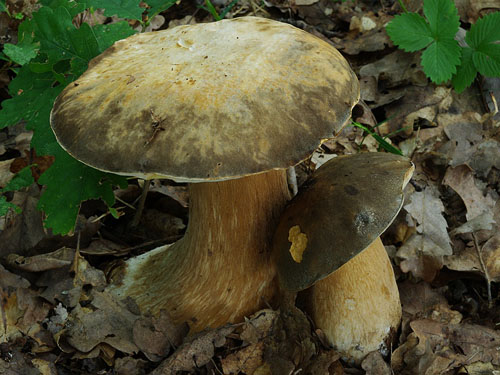
Fruitbodies of Boletus aereus. Note the discolouration of the cap of the older fruitbody. (photo M. Mikšík)
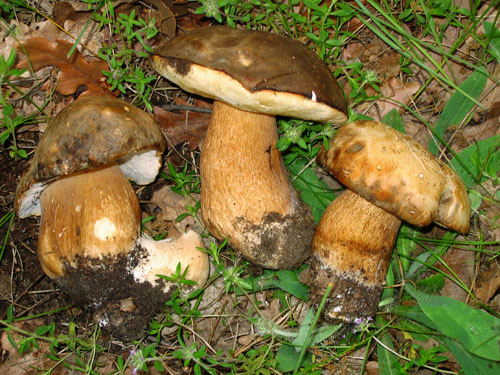
Fruitbodies of Boletus aereus. Note the colour variability. (photo B. Assyov)
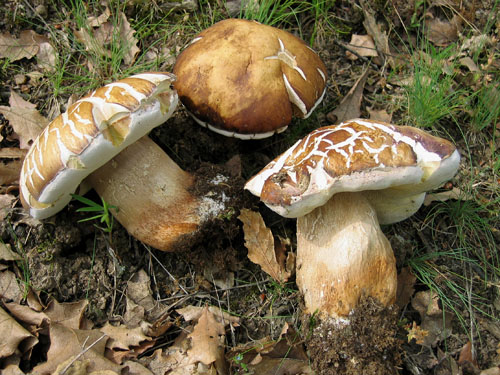
Fruitbodies of Boletus aereus. Note the colour variability and the cracking, sometimes seen in frutbodies grown in dry conditions. (photo B. Assyov)
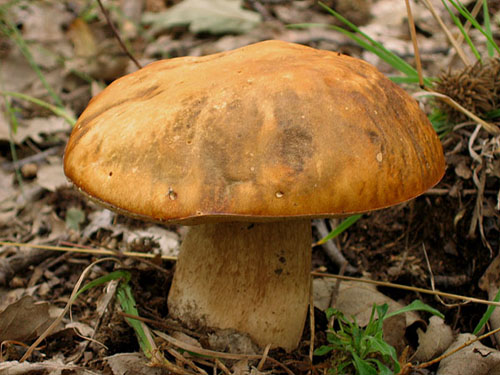
Fully developed fruitbody of Boletus aereus. Note the cap colour that is sometimes seen in this species. (photo B. Assyov)
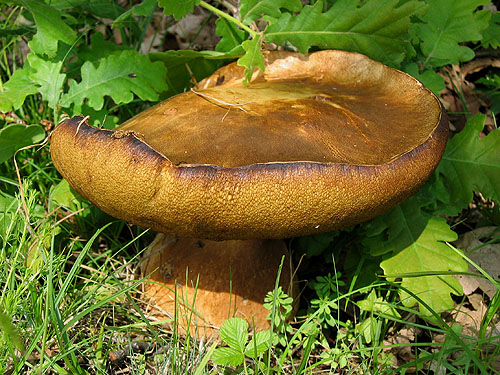
Old fruitbody of Boletus aereus. (photo B. Assyov)
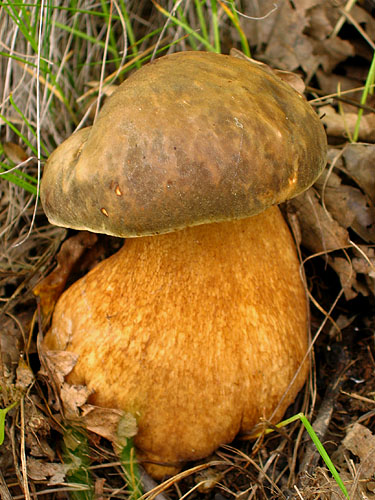
Young fruitbody of Boletus aereus. (photo B. Assyov)
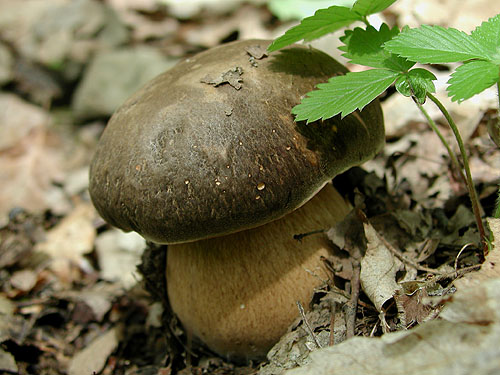
Very young fruitbody of Boletus aereus. Note the cap colour. (photo B. Assyov)
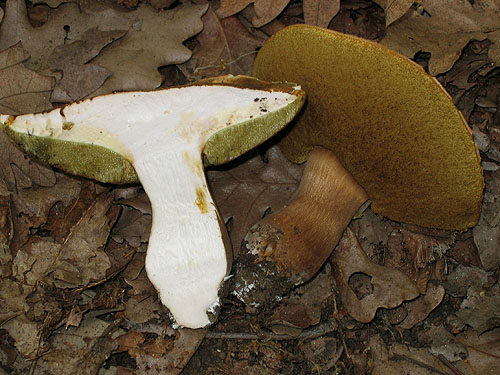
Fruitbody of Boletus aereus. Note the white unchanging flesh. (photo B. Assyov)
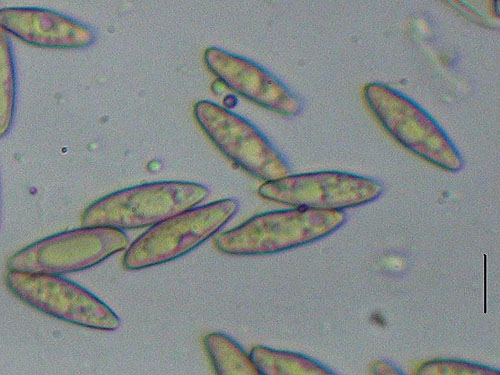
Spores of Boletus aereus. Scale bar = 10 μm. (photo B. Assyov)
Important literature
Alessio, C.L. 1985. Boletus Dill. ex L. (sensu lato). – In: Fungi Europaei. Vol. 2. Pp. 1–705. Libreria editrice Biella Giovanna, Saronno.
Dentinger, B.T.M., Ammirati, J.F., Both, E.E, Desjardin, D.E., Halling, R.E., Henkel, T.W., Moreau, P.-A., Nagasawa, E., Soytong, K., Taylor, A.F., Watling, R., Moncalvo, J.M. & McLaughlin, D.J. 2010. Molecular phylogenetics of porcini mushrooms (Boletus section Boletus). – Molecular Phylogenetics and Evolution 57: 1276–1292. (available online)
Engel, H., Krieglsteiner, G., Dermek, A. & Watling, R. 1983. Dickröhrlinge. Die Gattung Boletus in Europa. Verlag Heinz Engel, Weidhausen b. Coburg.
Estadès, A. & Lannoy, G. 2004. Les bolets européens. – Bulletin Mycologique et Botanique Dauphiné-Savoie 44(3): 3–79.
Galli, R. 1998. I Boleti. Atlante pratico-monographico per la determinazione dei boleti. Edinatura, Milano.
Knudsen, H. & Vesterholt, J. [eds.]. 2008. Funga Nordica. Nordsvamp, Kopenhagen.
Lannoy, G. & Estadès, A. 2001. Les Bolets. Flore mycologique d’Europe. Documents Mycologiques Mémoire Hors série no. 6. Pp. 1–163. Association d’Écologie et de Mycologie, Lille.
Muñoz, J.A. 2005. Boletus s. l. – In: Fungi Europaei. Vol. 1. Pp. 1–951. Edizioni Candusso, Alassio.
Pilát, A. & Dermek, A. 1974. Hríbovité huby. Československé hríbovité a sliziakovité huby (Boletaceae – Gomphidiaceae). Veda, Bratislava.
Redeuilh, G. 1978. Boletus mamorensis nov. sp. – Bulletin Trimestriel de la Société Mycologique de France 94: 299–303.
Singer, R. 1967. Die Röhrlinge. II. Die Boletoideae und Strobilomycetaceae. – In: Die Pilze Mitteleuropas. Vol. 6. Pp. 1–151. Julius Klinkhardt Verlag, Bad Heilbrunn.
Šutara, J., Mikšík, M. & Janda, V. 2009. Hřibovité houby. Čeled’ Boletaceae a rody Gyrodon, Gyroporus, Boletinus a Suillus. Academia, Praha.
Watling, R. 1970. Boletaceae, Gomphidiaceae, Paxillaceae. – In: Henderson, D.M., Orton, P.D. & Watling, R. [eds]. British fungus flora. Agarics and Boleti. Vol. 1. Royal Botanic Garden, Edinburgh.
Watling, R. & Hills, A.E. 2005. Boletes and their allies (revised and enlarged edition). – In: Henderson, D.M., Orton, P.D. & Watling, R. [eds]. British Fungus Flora. Agarics and boleti. Vol. 1. Royal Botanic Garden, Edinburgh.